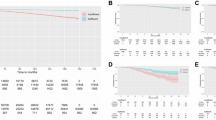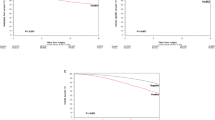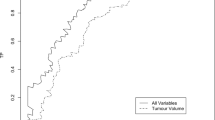Abstract
Background
While both the number (+LN) and density (LND) of metastatic lymph nodes on radical prostatectomy lymphadenectomy predict mortality in prostate cancer, the independent impact of each on overall mortality (OM) is unknown.
Methods
We sampled men who underwent radical prostatectomy and lymphadenectomy between 2004 and 2013 from the National Cancer Database. Multivariable Cox proportional hazards analysis with restricted cubic spline was used to assess the non-linear association of +LN count and LND with OM.
Results
Of 229,547 men in our sample, 3% (n = 7507) had +LNs, of which 89% had 1-3 +LN and 11% had ≥4 +LN. In multivariable Cox analysis across all patients, OM increased with each additional +LN up to four (HR 1.14, 95%CI 1.06–1.23 per node), with no increase beyond 4 +LN. LND was an independent predictor of OM (HR 1.09, 95%CI 1.06–1.12 per 10% increase). However, after excluding patients with inadequate nodal sampling (<5 LN examined), the variation in OM explained by LND was negligible for patients with ≤3 +LN. In men with 1, 2, and 3 +LN, there was a 0.28%, 0.02%, and 0.50% increase in OM for each 10% increase in LND, compared with 1.9% and 1.6% for men with 4 or 5+ LNs.
Conclusions
While +LN count and LND independently predict OM, the impact of LND is negligible in men with ≤3 +LN, who comprise the vast majority of men with +LN. Pathological nodal staging should primarily rely on LN count rather than LND.
This is a preview of subscription content, access via your institution
Access options
Subscribe to this journal
Receive 4 print issues and online access
$259.00 per year
only $64.75 per issue
Buy this article
- Purchase on Springer Link
- Instant access to full article PDF
Prices may be subject to local taxes which are calculated during checkout



Similar content being viewed by others
References
Abdollah F, Dalela D, Sood A, Keeley J, Alanee S, Briganti A, et al. Impact of Adjuvant Radiotherapy in Node-positive Prostate Cancer Patients: The Importance of Patient Selection. Eur Urol. 2018;74:253–6.
Briganti A, Karnes RJ, Da Pozzo LF, Cozzarini C, Capitanio U, Gallina A, et al. Combination of adjuvant hormonal and radiation therapy significantly prolongs survival of patients with pT2-4 pN+ prostate cancer: results of a matched analysis. Eur Urol. 2011;59:832–40.
Cheng L, Zincke H, Blute ML, Bergstralh EJ, Scherer B, Bostwick DG. Risk of prostate carcinoma death in patients with lymph node metastasis. Cancer 2001;91:66–73.
Daneshmand S, Quek ML, Stein JP, Lieskovsky G, Cai J, Pinski J, et al. Prognosis of patients with lymph node positive prostate cancer following radical prostatectomy: long-term results. J Urol. 2004;172:2252–5.
Gupta M, Patel HD, Schwen ZR, Tran PT, Partin AW. Adjuvant radiation with androgen-deprivation therapy for men with lymph node metastases after radical prostatectomy: identifying men who benefit. BJU Int. 2019;123:252–60.
Messing EM, Manola J, Sarosdy M, Wilding G, Crawford ED, Trump D. Immediate hormonal therapy compared with observation after radical prostatectomy and pelvic lymphadenectomy in men with node-positive prostate cancer. N Engl J Med. 1999;341:1781–8.
Messing EM, Manola J, Yao J, Kiernan M, Crawford D, Wilding G, et al. Immediate versus deferred androgen deprivation treatment in patients with node-positive prostate cancer after radical prostatectomy and pelvic lymphadenectomy. Lancet Oncol. 2006;7:472–9.
Touijer KA, Karnes RJ, Passoni N, Sjoberg DD, Assel M, Fossati N, et al. Survival Outcomes of Men with Lymph Node-positive Prostate Cancer After Radical Prostatectomy: A Comparative Analysis of Different Postoperative Management Strategies. Eur Urol. 2018;73:890–6.
Mohler JL, Antonarakis E, Armstrong AJ. Prostate cancer, version 2.2019, NCCN clinical practice guidelines in oncology. J Natl Compr Canc Netw. 2019;17:479.
Phillips R, Shi WY, Deek M, Radwan N, Lim SJ, Antonarakis ES, et al. Outcomes of Observation vs Stereotactic Ablative Radiation for Oligometastatic Prostate Cancer: The ORIOLE Phase 2 Randomized Clinical Trial. JAMA Oncol. 2020;6:650–9.
Bader P, Burkhard FC, Markwalder R, Studer UE. Disease progression and survival of patients with positive lymph nodes after radical prostatectomy. Is there a chance of cure? J Urol. 2003;169:849–54.
Boorjian SA, Thompson RH, Siddiqui S, Bagniewski S, Bergstralh EJ, Karnes RJ, et al. Long-term outcome after radical prostatectomy for patients with lymph node positive prostate cancer in the prostate specific antigen era. J Urol. 2007;178:864–70.
Briganti A, Karnes JR, Da Pozzo LF, Cozzarini C, Gallina A, Suardi N, et al. Two positive nodes represent a significant cut-off value for cancer specific survival in patients with node positive prostate cancer. A new proposal based on a two-institution experience on 703 consecutive N+ patients treated with radical prostatectomy, extended pelvic lymph node dissection and adjuvant therapy. Eur Urol. 2009;55:261–70.
Palapattu GS, Allaf ME, Trock BJ, Epstein JI, Walsh PC. Prostate specific antigen progression in men with lymph node metastases following radical prostatectomy: results of long-term followup. J Urol. 2004;172:1860–4.
Daskivich TJ, Luu M, Freedland SJ, Sandler H, Spratt DE, Zumsteg ZS. Development and Validation of an Improved Pathological Nodal Staging System in Men with Prostate Cancer. J Urol. 2021:101097JU0000000000002256.
Cai T, Nesi G, Tinacci G, Giubilei G, Gavazzi A, Mondaini N, et al. Clinical importance of lymph node density in predicting outcome of prostate cancer patients. J Surg Res. 2011;167:267–72.
Passoni NM, Abdollah F, Suardi N, Gallina A, Bianchi M, Tutolo M, et al. Head-to-head comparison of lymph node density and number of positive lymph nodes in stratifying the outcome of patients with lymph node-positive prostate cancer submitted to radical prostatectomy and extended lymph node dissection. Urol Oncol. 2014;32:29.e1–8.
Grambsch PM, Therneau TM. Proportional hazards tests and diagnostics based on weighted residuals. Biometrika 1994;81:515–26.
Abdollah F, Karnes RJ, Suardi N, Cozzarini C, Gandaglia G, Fossati N, et al. Impact of adjuvant radiotherapy on survival of patients with node-positive prostate cancer. J Clin Oncol. 2014;32:3939–47.
Nguyen AT, Luu M, Nguyen VP, Lu DJ, Shiao SL, Kamrava M, et al. Quantitative Nodal Burden and Mortality across Solid Cancers. J Natl Cancer Inst. 2022;114:1003–11.
Funding
Institutional
Author information
Authors and Affiliations
Contributions
JM—Writing - Original Draft, Investigation, Formal analysis. ML—Software, Formal analysis, Data Curation, Visualization. AN—Writing - Review & Editing, Investigation. SF—Writing - Review & Editing, Supervision. HS—Writing - Review & Editing, Supervision. ZZ—Writing - Review & Editing, Supervision. TD—Conceptualization, Methodology, Validation, Investigation, Resources, Writing - Review & Editing, Supervision.
Corresponding author
Ethics declarations
Competing interests
The authors declare no competing interests.
Additional information
Publisher’s note Springer Nature remains neutral with regard to jurisdictional claims in published maps and institutional affiliations.
Supplementary information
Rights and permissions
Springer Nature or its licensor (e.g. a society or other partner) holds exclusive rights to this article under a publishing agreement with the author(s) or other rightsholder(s); author self-archiving of the accepted manuscript version of this article is solely governed by the terms of such publishing agreement and applicable law.
About this article
Cite this article
Masterson, J.M., Luu, M., Naser-Tavakolian, A. et al. Concurrent prognostic utility of lymph node count and lymph node density for men with pathological node-positive prostate cancer. Prostate Cancer Prostatic Dis (2023). https://doi.org/10.1038/s41391-022-00635-1
Received:
Revised:
Accepted:
Published:
DOI: https://doi.org/10.1038/s41391-022-00635-1



